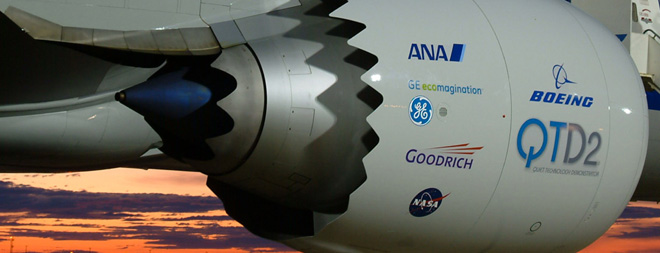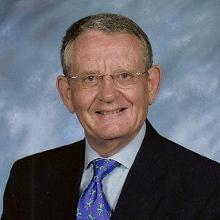Playing Skillfully With a Loud Noise

he exhaust emitted from jet engines creates noise through a frictional effect as it slows down.
NASA
Image rights: Used with permission.
(ISNS) -- To simulate landing supersonic jets on aircraft carriers in heavy seas, U.S. Navy pilots fly over land -- almost always in the early hours of the morning, when the screech of their engines on takeoff and landing disturbs the sleep of local residents.
But technology sponsored by the Navy promises to give the neighbors more peaceful nights. It works by interfering with the turbulence in jet engines that causes the noise.
The technology adds a new twist to a method recently introduced in civilian aircraft. That method involves shaping the rear end of jet engines -- the region through which the exhaust travels -- into a pattern of curves. The curves, called chevrons or cutouts, decrease the amount of turbulence in the exhaust. But they also reduce the engine's fuel efficiency slightly.
The new approach, under investigation by engineers from the University of Cincinnati and the Naval Research Laboratory, affects turbulence more actively.
A small airflow introduced into the engine ahead of the exhaust influences the turbulence in much the same way as the chevrons. Pilots can save fuel by turning off this "fluidic technology" once the plane is in the air, when noise suppression is no longer needed.
"We are in the business of trying to quiet planes without impacting their fuel efficiency," said Jeff Kastner from the University of Cincinnati.
Kastner highlighted his team's studies of chevrons and fluidic technology at the Internoise 2012 Congress Aug. 21 in New York City.
"The military is willing to pay to obtain quieter engines," said James Bridges, a jet-noise researcher at NASA's Glenn Research Center in Cleveland who did not participate in Kastner's investigation.
The exhaust emitted from jet engines creates noise through a frictional effect as it slows down.
"It's like the noise you get when you slam on the brakes in your car," Kastner explained. "The faster the exhaust, the louder the noise."
When supersonic jets take off and land, they do more than disturb people's sleep. The noise also stresses jet aircraft's components and helps potential enemies to identify the planes.
Chevrons reduce the noise by interfering with the direction of the turbulence in engines' exhaust.
"Engine exhaust tends to be unidirectional," Kastner said. "Chevrons disturb the flow. They make it more three-dimensional, at which point the process becomes less efficient. You may still have more turbulence, but it's not as effective at producing noise."
Manufacturers such as Boeing accept the small reduction in fuel efficiency that accompanies the chevrons they have introduced in their latest types of airliner. But because military jets consume far more fuel at supersonic speeds, the loss in efficiency presents a more serious problem. So far no military aircraft have been fitted with chevrons.
Fluidic technology offers a means of complementing chevrons in military aircraft while minimizing the loss in fuel efficiency.
"It's a bleed placed in an earlier part of the engine. You're basically blowing the fluidic air perpendicular to the main flow," Kastner said. "The number one thing is that you can turn it on and off."
Pilots could switch on the technology during takeoffs and landings, when the engine noise causes the greatest distress, and turn it off once in the air.
Alternatively, the technology could be pre-set like the cruise control system in automobiles.
"The plane could be programmed to turn off the fluidics at will," Kastner said. "But the pilot could override it."
Previous studies of fluidic technology have produced mixed results.
"We have seen some significant positive impacts, as well as some seriously negative ones," Bridges said. "The trick is in how you do it."
At the Internoise Congress, Kastner presented the results of studies on both noise-reducing technologies in a money-saving experimental set-up that uses engines one-tenth the size of those in military jets.
"Results show appreciable noise reduction by both fluidic injection and chevrons," Kastner reported.
If further results prove out the concepts, the military could soon insist on incorporating the technologies in their jet aircraft.
Bridges cautions that adding chevrons and fluidics to jet engines will require some skill.
"It's not just a matter of slap it on and go with it," Bridges said.
It's also possible that the military could opt for fluidic technology alone, given its advantage in fuel efficiency.
"It could replace chevrons," Kastner said. "But merging the two technologies could be more advantageous for military aircraft. When a plane goes supersonic it could be a little harder to control with fluidic flow alone."

